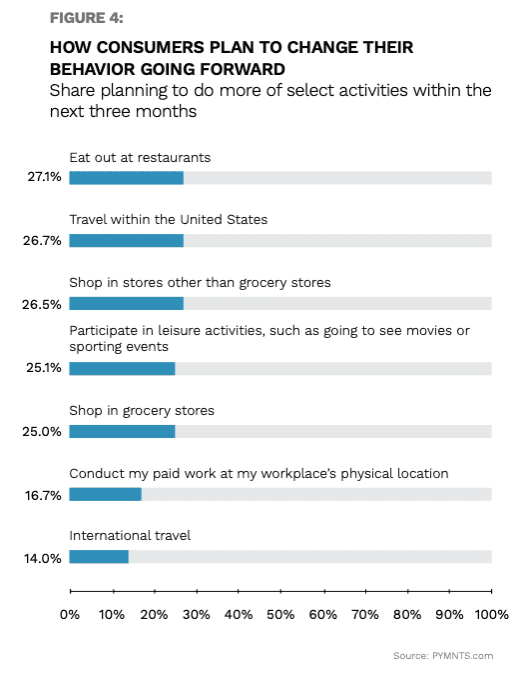
When Delta Airlines recently reported its first quarterly profit since the start of the pandemic, it was seen as a positive sign of recovery for the entire airline sector, but it may also signal good news for certain retail categories, such as luggage, that suffered because of COVID-19 travel restrictions.
See: Delta Airlines’ Q3 Profit May Signal Wider Takeoff of Pent-Up Travel Demand
PYMNTS data show that nearly 27% of consumers plan to travel within the United States more in the next three months and 14% intend to travel more internationally. More than one-quarter of consumers also say they plan to shop more often in brick-and-mortar retail shops.

Read more: New Data: Only One-Quarter of Post-Pandemic Consumers Eager To Get Out — and Spend — More
The luggage market was valued at $22 billion in 2019, according to Statista, but fell to $16 billion last year when COVID-19 restricted most people to the confines of their homes. The category is expected to see a recovery over the next several years, jumping to a $19 billion market value by next year and to $22.3 billion by 2024.
But it’s more than travel that’s rebounding, and more than luggage that will see a boost. Almost 17% of consumers say they plan to start working in their employer’s office again in the next three months, which for many will necessitate a new wardrobe after months of more casual attire. About one-third of Americans’ waistlines changed during the pandemic, clothing company Levi Strauss & Co. has estimated, and even those who haven’t gained or lost weight likely want to update their style.
Sales at clothing stores rose 1.1% in September, according to data released by the U.S. Commerce Department, and general merchandise stores saw a 2% sales bump. At department stores specifically, the sales growth was 0.9%.
See more: Retail Sales Up 0.7% in September as Inflation Continues to Rise
Looking year-over-year, clothing stores have seen a 22% increase in sales; general merchandise stores have seen a 13% increase; and department stores have seen a 19% jump in sales, though a share of these increases can likely be attributed to rising inflation.
Mastercard SpendingPulse has also projected a 16% increase in apparel sales compared to 2019 between October and December and a 5% increase in department store sales over the same time period.
More: Mastercard Predicts 7.4% Retail Growth During Holiday Shopping Season
The Optimistic Consumer
To be sure, previous signs and predictions of pandemic recovery have given way to the realities of new COVID-19 variants that have caused employers to delay office reopening plans and consumers to hold back their spending, but in recent months, industry watchers have remained optimistic.
Target CEO Brian Cornell, for example, in August told analysts that despite the delta variant, consumers remained “very optimistic,” albeit while shopping with caution and wearing a face mask. “We’re seeing tremendous resilience in the consumer today, and our traffic patterns represent that,” he said.
Full story: Target CEO Sees ‘Tremendous Resilience’ In Consumers Amid Renewed COVID Concerns
Additionally, PYMNTS research has found that consumers are now more worried about the pandemic’s impact on the economy than its impact on their health, with 62% reporting strong economic concerns and 48% reporting strong health concerns.
Steve Sadove, former CEO of Saks and senior adviser at Mastercard, also told Karen Webster in a recent conversation that consumer demand remains “very healthy,” with no slowdown on the horizon. “In the near term, meaning through the holidays, we’re in a really good environment for the consumer,” Sadove said.
Read more: Holiday 2021: Pent-Up Consumer Demand, Test of In-Store Experience For Retailers
Consequences of Demand
This pent-up demand, though, is in part contributing to the global supply chain issues around the world. In the first nine months of the year, retail sales were up 14.5% over the same period in 2020, a year in which retail sales jumped 8% compared to 2019. The National Retail Federation (NRF) projected in June that retail sales this year would likely grow between 10.5% and 13.5%, totaling over $4.44 trillion.
See: NRF: US Consumers Expected To Propel Retail Sales To Over $4.44 Trillion In 2021
NRF Chief Economist Jack Kleinhenz said in a statement last week that consumers “still have a hyper-ability to spend thanks to wage and job gains and the household savings built up during the pandemic.”
“Nonetheless, rising inflation and slower supply chains remain a concern,” he added, noting that spending in September “might have been higher if not for shortages of items consumers are eager to purchase.”
Readers also liked: Industries Try Allocations, Alternate Vendors and New Forms of Transportation to Work Around Supply Chain Problems